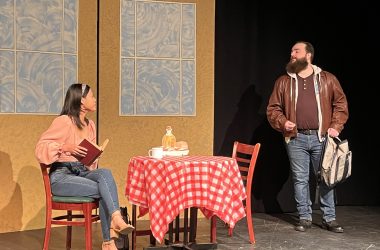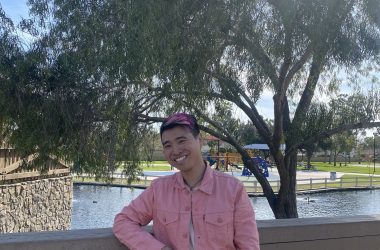The weekly student art galleries offer a multitude of visual art from students. Pieces this week range from acrylic paint on campus to graphite on paper and high-definition video.
This week in the Werby gallery, Masood Kamandy’s “Unspoken Portrait” draws attention as the only live-action portrait in the gallery that demonstrates the art of editing or “cutting” with the interpretation of an image if it lacks verbal communication.
Kamandy’s subject is a young woman, dressed in an old-fashioned, maid-inspired dress, speaking directly to the person behind the camera. As if she is telling a story, the woman speaks continuously, but in a way that the listener can’t really understand what she is saying. The artist’s role as editor of the video portrait is evident because though inaudible sounds, a viewer can make out the beginning and endings of words. The young woman is experiencing a series of emotions in the video, from talkative and joyous to pensive and flustered, while telling the cameraman a story that would later be edited and cut. After eight minutes of looped words and gibberish, viewers can become pensive and flustered as well.
“The girl looked like someone trying to get her point across but was having trouble or no means of communication,” said Monique Nicholson, sophomore communicative disorders major. “I can almost relate [to her]. She [seems] suppressed by her speech disability or by people that are looking down at her.”
Kamandy edited out all of the words but left the thoughtful pauses, “umms”, giggles and murmurs the young woman offers, completely unedited. The cutting of the video suggests that there is no rush for the woman to get her point across. This leaves viewers to wonder and even assume that she is a representation of a suppressed and disabled person.
She stretches, fidgets and yawns, looks up and around but says nothing. The overly-edited video is an example of the many ways an image can be interpreted if you remove all verbal communication and leave the viewer to assume. The video continues in a half-spoken conversation between the girl and the person behind the camera, and suggests the question of “What is her point?”
By altering the words in the video, Kamandy forces the viewer to pay attention to the emotion and the body language of his subject. Ultimately, Kamandy’s “Unspoken Portrait” makes viewers impatient for the girl to say what she wants to say.
Directly across from Kamandy’s curious video is Melise Mestayer’s detailed and colorful “Gummy Brain”. Made of gummy worms, hot glue, chicken wire and plaster, the gummy brain is one of the most appealing attractions in the Werby gallery.
“It looked like the most vibrant piece in the room to me,” said Raven Sherman, junior photography major. “It kind of resembled a brain turning to mush.”
The gummy worm brain has viewers circling around it, admiring how detailed and crisp a sculpture of a brain could be with the use of gummy worms as the primary medium. The gummy brain sculpture allows people to take a look at something very similar to an actual brain — minus the real cerebral tissue and the rest of one’s body content.
The student art galleries run Sunday through Thursday between noon and 5 p.m. by the Fine Arts buildings.
Disclaimer: The Daily 49er is not responsible for Postings made on www.daily49er.wpengine.com. Persons commenting are solely responsible for Postings made on this website. Persons commenting agree to the Terms of Use of the website. If Postings do not abide by the Rules of Conduct or Posting Regulations as listed in the Postings Policy, the Daily 49er has all rights to delete Postings as it deems necessary. The Daily 49er strongly advises individuals to not abuse their First Amendment rights, and to avoid language suggestive of hate speech. This site also encourages users to make Postings relevant to the article or other Postings.




